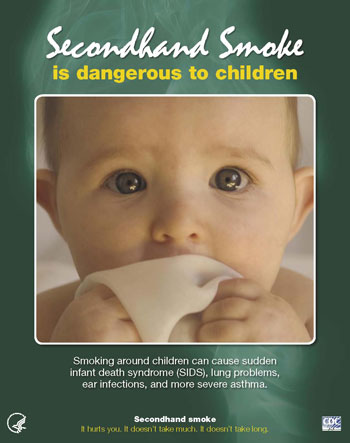 February 21, 2010 - The most comprehensive study to date of secondhand smoke (SHS, environmental tobacco smoke, ETS, sidestream, passive, involuntary smoking) exposure among children in England is published in the journal Addiction (see link to abstract below). The study, carried out by researchers from the University of Bath's School for Health, reveals that exposure to household secondhand smoke among children aged 4-15 has declined steadily since 1996.
February 21, 2010 - The most comprehensive study to date of secondhand smoke (SHS, environmental tobacco smoke, ETS, sidestream, passive, involuntary smoking) exposure among children in England is published in the journal Addiction (see link to abstract below). The study, carried out by researchers from the University of Bath's School for Health, reveals that exposure to household secondhand smoke among children aged 4-15 has declined steadily since 1996.
PAPER: Sims M., Tomkins S., Judge K., Taylor G., Jarvis M.J., Gilmore A. Trends in and predictors of secondhand smoke exposure indexed by cotinine in children in England from 1996-2006. Addiction 2010; 105: 543-53, ABSTRACT.
The researchers wanted to find out if there were ways to predict the levels of secondhand smoke encountered by children in private households, and whether those levels were changing over time. Using eight surveys conducted between 1996 and 2006, researchers took saliva samples from over 19,000 children aged 4-15 years. The saliva samples were analyzed for a substance called cotinine, an indicator of tobacco smoke exposure. (Cotinine a metabolite of nicotine, has an in vivo half life of approximately 20 hours, and is typically detectable for several days to up to one week after the use of tobacco.)
The results show that the average cotinine levels among non-smoking children declined by 59% from 1996 to 2006, indicating that children's exposure to secondhand smoke has decreased markedly since the mid-nineties. The researchers point out that the largest decline was between 2005 and 2006, a time of increased public debate and public information campaigns about secondhand smoke in the lead-up to the 2007 implementation of smoke-free legislation for public spaces.
The research also reveals that secondhand smoke exposure in non-smoking children is highest when one or both parents smoke, when the children are looked after by carers that smoke, and when smoking is allowed in the home. Dr Michelle Sims, first author of the paper, adds: "the importance of carer and parental smoking and household exposure tells us that reducing exposure in the home is the key to reducing the health risks associated with secondhand smoke exposure in children."
Dr Anna Gilmore, who led the project, said "this study shows that the factors which most strongly influence children's exposure are modifiable. Parents and carers can reduce their children's exposure to smoke by giving up smoking, or failing this, making a decision to smoke outside the house. Stopping others from smoking in their house is also important. The fact that children's exposure has already fallen so markedly shows that making these changes is feasible."
We never understood why there was a need for Action on Smoking and Health (ASH) UK to call for a debate in England on banning smoking in all cars. Is a debate necessary - this is a no-brainer - just get it done.
Reference: Study indicates children's exposure to secondhand smoke has decreased markedly since mid-nineties, The Medical News, 2/8/2010.
Bringing the World of Tobacco Control closer together..
England - decline in kids secondhand smoke exposure - we can do better..
Subscribe to:
Post Comments (Atom)


To Provide Public Awareness
Purpose
About Us
Contact Us
2008 HIGHLIGHTS
TOPIX PAPERS - 2008 & 2009..
Archive
-
▼
2010 (1530)
-
▼
02/21 - 02/28 (31)
- NHS's VIDEO: Children worry about parents' smoki...
- BAT - 2009 financial statement..
- OHIO - judge stops collection of fines against a b...
- WHO FCTC - world health treaty's 5th anniversary..
- Bulgaria - justifying why smoking ban won't go int...
- Kansas - public smoking ban effective July 1, 2010.
- VIDEO: England - dead smoker sends warning from th...
- Bulgaria - Citigroup chosen as consultant for sal...
- Florida - jury reduces $300 million verdict agains...
- Quebec, Canada - turning immigrant kids into smoke...
- Philippines - PMI - FTC merger may lead smokers co...
- Philippines - PMI and Fortune Tobacco Corp. form...
- France - anti-smoking shock ad aimed at teens..
- Philippines - Tanauan City names street Philip Mor...
- Philippines - DOH campaign for 100% smoke-free wor...
- Scientific journal will no longer publish papers ...
- Israeli study - are non-smokers smarter than smokers?
- Idaho - state senator whose husband is a tobacco ...
- Cuba - premium cigar sales down look to women to i...
- Smoking Cessation - Chantix (Champix) vs. Cold T...
- Public health groups file petition with U.S,. Supr...
- Bulgaria - ruling party may delay smoking ban unt...
- Bulgaria - Finance Minister Djankov, " Less Smoki...
- VIDEO - VOA: More US Companies Refuse to Hire Smok...
- Hong Kong - cigarettes too cheap, tax only 61 and...
- U.S. federal govt and 3-cigarette makers asked th...
- VIDEO - VOA: Smoking in Africa; The Busines, The C...
- Star Scientific asks FDA to certify lozenge les...
- England - decline in kids secondhand smoke exposur...
- UK - sales of quit aids soars but smoking remains ...
- To quit, 'nicotine-free' smokes as good as lozenge...
-
▼
02/21 - 02/28 (31)
© Copyright Notice: The content of this website is for information education purposes only and any newsbrief may be used only as "fair use" for information/education purposes with permission of the authors and providing that original references and associated reference links are included in HTML format.
0 comments:
Post a Comment